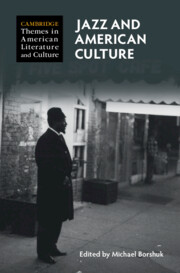Book contents
- Jazz and American Culture
- Cambridge Themes in American Literature and Culture
- Jazz and American Culture
- Copyright page
- Contents
- Contributors
- Acknowledgments
- Introduction
- Part I Elements of Sound and Style
- Part II Aesthetic Movements
- 5 Jazz Age Harlem
- 6 “Hard Times Don’t Worry Me”
- 7 A Fool for Beauty
- 8 Free Jazz, Critical Performativity, and 1968
- Part III Cultural Contexts
- Part IV Literary Genres
- Part V Images and Screens
- Bibliography
- Index
5 - Jazz Age Harlem
from Part II - Aesthetic Movements
Published online by Cambridge University Press: 09 November 2023
- Jazz and American Culture
- Cambridge Themes in American Literature and Culture
- Jazz and American Culture
- Copyright page
- Contents
- Contributors
- Acknowledgments
- Introduction
- Part I Elements of Sound and Style
- Part II Aesthetic Movements
- 5 Jazz Age Harlem
- 6 “Hard Times Don’t Worry Me”
- 7 A Fool for Beauty
- 8 Free Jazz, Critical Performativity, and 1968
- Part III Cultural Contexts
- Part IV Literary Genres
- Part V Images and Screens
- Bibliography
- Index
Summary
This chapter considers the material and violent circumstances that surrounded Black performers such as Louis Armstrong, Ethel Waters, Bessie Smith, Duke Ellington, Fredi Washington, and Fats Waller, as they produced some of the most memorable work of the Harlem Renaissance. To survive, these artists employed strategies of gender fugitivity to navigate a world of labor, poverty, and policing, while claiming spaces of survival and creativity. The first of three sections explores fugitive gender, arguing that the purposeful instability caused through the relationship between gender and Blackness created the conditions of possibility in everyday life for Black folks. The second section excavates the meanings of Duke Ellington’s cosmopolitan dandyism as seen in the 1929 film Black and Tan.The final section considers the fugitive sociality of rent parties, informal musical venues born of necessity and delight, which served the community of Harlem by providing shelter, food, entertainment, and sexual pleasure.
- Type
- Chapter
- Information
- Jazz and American Culture , pp. 81 - 95Publisher: Cambridge University PressPrint publication year: 2023

